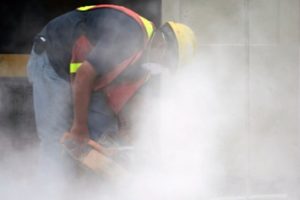OSHA’s new standard for respirable silica in construction is (almost) fully enforceable, as of October 23, 2017. Except for requirements that apply to sample analysis procedures used by laboratories, which become effective next June, employers who are covered under the standard should be in compliance with the requirements. But do you know whether you’re covered under the standard?
The standard includes some complete or partial exemptions for employers whose workers are unlikely to be overexposed, or whose employers have put specific protective measures in place. Here’s how to determine if you fall into one of those categories.
Are You Exempt? Maybe Just a Little?
In the new standard, the Occupational Safety and Health Administration (OSHA) offers some degree of exemption from the more onerous compliance requirements under specific circumstances. According to OSHA, the purpose of identifying these exemptions is to enable employers “to focus their resources on exposures of greater occupational health concern.”
You may be exempt from some of the requirements of the standard if:
Employee exposures are below 25 μg. Do you anticipate that employee exposures to respirable crystalline silica in your workplace will remain below the OSHA Action Level of 25 micrograms (μg) per cubic meter of air, as an 8-hour time-weighted average, without the implementation of engineering controls, under any foreseeable conditions (OSHA considers the failure of engineering controls a “foreseeable condition”)? If so, you are exempt from the requirements of the standard. This exemption is based on total respirable crystalline silica exposures from all sources and must take into account all conditions that may add or contribute to the employee’s overall exposure levels.
According to OSHA, some tasks can reasonably be expected to have exposures that remain below this threshold. Representative tasks suggested by OSHA include:
- Mixing concrete for post holes
- Pouring concrete footers, slab foundation, and foundation walls
- Removing concrete formwork
In addition, some employees in the construction sector may perform tasks that involve only occasional, brief exposures to respirable crystalline silica that are incidental to their primary work. If these exposures last 15 minutes or less, and occur no more often than once per shift, OSHA believes that employers can reasonably anticipate that the 8-hour time weighted average (TWA) will remain under the 25 μg/m3 threshold and, therefore, the standard would not apply. These workers include carpenters, plumbers, and electricians who occasionally drill holes in concrete or masonry or perform other tasks that involve exposure to respirable crystalline silica.
You have implemented protective measures under Table 1. In Table 1 of the standard, OSHA has identified some operations and pieces of equipment for which specific engineering and work practice controls are deemed to be sufficient exposure protection. Employers who have “fully and properly implemented the engineering controls, work practices, and respiratory protection” listed in Table 1 are not required to conduct exposure assessments or otherwise comply with the permissible exposure limit for those employees.
If Not …
If your employees may be exposed to respirable crystalline silica above the Action Level, or if they are engaged in tasks not listed in Table 1, or if you have not fully implemented the protective measures listed in Table 1, you’re out of luck: you must comply with the permissible exposure limit (PEL), exposure assessment, and methods of compliance requirements.
OSHA has issued a memorandum to its Compliance Safety and Health Officers on how to assess compliance with the new standard. More will be discussed on that tomorrow.

